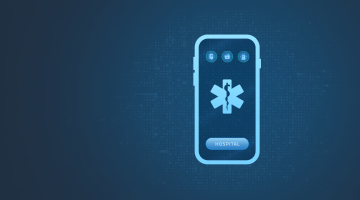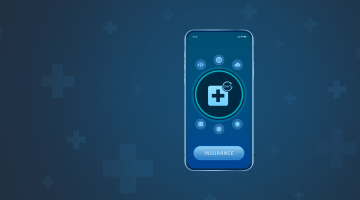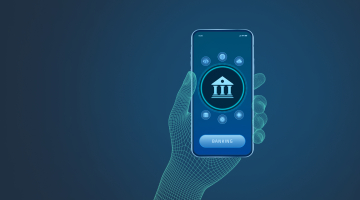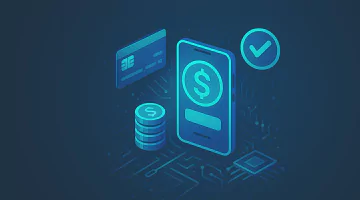

Digital wallet app development: Benefits and key features
With mobile devices getting across-the-board traction, people have started to employ mobile apps for an ever-growing number of use cases, including work, learning, entertainment, healthcare, you name it. Since most of these services aren’t free, we must pay for them. Logically, if we enjoy something via our mobile phones, we should be able to use our gadgets to pay for products and services we acquire. It can be done by leveraging digital payment apps, also known as mobile wallet apps.
This article will inform you on the spread and benefits of digital wallet apps, list business verticals that stand to gain from mobile wallet app development, highlight must-have and optional features of mobile wallets, and outline technologies and development steps necessary to create a successful digital wallet app.
A brief glimpse of the mobile wallet market
Before taking a look at the condition and prospects of the e-wallet app domain, let’s clarify what a digital/online wallet is. It is a web-based or mobile application (in the latter case, such solutions are called mobile wallets) that enables users to perform financial transactions (open a bank account, transfer money, manage funds, make bill payments, and the like) from their mobile gizmo. Digital payments conducted through them elevate user satisfaction to a new level, streamlining and facilitating all financial operations directed from this one-stop shop.
As modern civilization rapidly moves towards a cashless world, the digital wallet space constantly expands, gradually ousting traditional payment methods and physical payment cards. Three years ago, McKinsey and Company estimated the level of mobile payments penetration at 89%, and today, it is sure to have reached 100%, with 2.8 billion people across the globe using Google Pay, Apple Pay, PayPal One Touch, Samsung Pay, and other digital wallets.
The ubiquity of online payments explains the gigantic size of the digital wallet market that, in the US alone, topped $3 billion last year and is expected to almost reach the mind-blowing $19 trillion by 2030, increasing at a breathtaking CAGR of 30.1%.
What perks do such fintech solutions bring to financial service providers and consumers?
Zooming in on digital wallet benefits
What do users obtain when they create a digital wallet on their smartphone?
Digital wallet benefits
Accessibility
No more need to carry your physical credit card with you and worry about it being lost or damaged. Mobile payment apps connected to their bank accounts allow people to perform the same financial operations from their mobile devices.
Multi-functionality
Digital wallet features enable consumers to employ them in a variety of use cases – from buying groceries, tickets, and other items to booking hotel rooms, renting vehicles, and transferring money.
High-level security
Modern digital wallets rely on robust security measures to adhere to general data protection regulations and guarantee secure data transmission and storage because card and bank account data are kept secret during transactions. Besides, they use multi-factor authentication (typically prioritizing biometric authentication) procedures to ensure the app is utilized only by the device owner.
Automatic payments
In our hectic lives, we are torn between several responsibilities, often forgetting about some errand (like paying utility bills or credit installments). By setting up automatic payments in your digital wallet, you can turn to other duties, being sure the software will do it regularly and faultlessly.
Expense tracking
You can view your total balance, transaction history, and spend analytics across all payment gateways to understand the major expenditure areas and revise your spending habits, thus optimizing finance management.
Bill splitting
If you like to travel in a large company or visit restaurants together with your friends or colleagues, the digital wallet can make sure everybody pays only for what they have consumed and help you avoid conflicts with your near and dear ones over money issues.
Rewards
As a rule, mobile wallets offer various loyalty programs, promotions, cashback, discounts, and other rewards for reaching certain milestones, purchasing from specific stores, etc.
Organizations that launch this cash app type also capitalize on mobile wallet application development.
Augmenting customer experience
User-friendly and secure digital wallets are second-to-none instruments for providing a target audience that is getting increasingly tech-savvy with ultimate financial experience, allowing for faster payment processing and portability of fintech services.
Staying ahead of the curve
By building a digital wallet, your company enters the vast and dynamically developing mobile payment market, which is a frontier in the fintech sector today. Thus, you keep abreast of the current trends in the financial and technological fields and get a sharp competitive edge over your rivals who haven’t yet grasped all the assets of digital wallet development.
Additional revenue sources
Digital wallet transactions create new opportunities for making money, such as in-app ads, transaction fees, partnerships with vendors, etc. Besides, when developing a digital wallet, you can fill it with advanced functionalities like cryptocurrency support or budgeting capabilities that, appealing to contemporary users, boost customer retention and foster brand loyalty.
Personalization of services
Properly crafted mobile wallets can capture valuable information concerning consumer preferences, pain points, buying habits, spending behavior, and other aspects. When supplemented by user feedback, such data becomes a collection of insights that serve as guidelines for developing personalized marketing strategies and launching highly targeted campaigns tailored to an individual client’s needs and expectations.
To maximize the value of these benefits both for consumers and businesses, you should equip your mobile wallet with an adequate roster of functionalities.
Key features of digital wallet apps
As an experienced app development company with in-depth expertise in the fintech realm, we at DICEUS know what capabilities are non-negotiable for a high-quality digital wallet. They can be grouped into several categories.
digital wallet app features
User account management
To start using the mobile wallet, a person should create the user profile, ensure secure access to it, and tailor the user interface characteristics to personalize the app experience. Such capabilities are provided via:
- Registration and login. Sign-up is essentially streamlined by email or social account registration.
- Security settings. At least two-factor authentication should be implemented to forestall unauthorized usage of the app.
- Multi-device synchronization. Owners should be able to access the app from all endpoints they operate.
- Profile customization. People should be able to upload photos or fill their profiles with personal details they would like to share.
Deposits and withdrawals
This set of features enables users to fund the wallet and withdraw money from it.
- Linking cards and accounts. One wallet may house several cards/accounts that are connected to it by the user.
- Debit/credit card integration. Wallet owners should be able to add new cards when they open other accounts.
- Cash-in at partner outlets. Using this feature, people can add funds via specific terminals or partner locations.
- Account replenishment. Wallet funds can be withdrawn back to the bank account.
Transaction features
These are the core capabilities responsible for handling all financial transactions. Here belong:
- Contactless payments. Users pay for products or services leveraging QR codes or NFC.
- Bill payments. Typically, people use it to pay utility or other bills, which is enabled by partnering with their respective service providers.
- Money transfers. Customers can send or receive money from other individuals (peer-to-peer transfers and bill-splitting options) and also exchange sums between several accounts they have.
- Transaction history. Clients should be able to check their balance and review past payments.
Plus, there are some must-have capabilities available in any banking app.
Push notifications
Even with the app not active, it keeps users informed and updated on important events and deadlines they shouldn’t miss, as well as successful or declined payments. Also, through notifications, the wallet asks for authorization, which is one of the most secure data protection methods.
Geolocation
Although the wallet is geared towards the cashless paradigm where neobanks reign supreme, its users should know where the nearest brick-and-mortar bank branches or ATMs are to solve possible issues or withdraw cash if the need arises.
Customer support
People should always be able to ask for advice or help if they encounter problems or have questions concerning wallet operation. Today, customer service is largely dependent on AI-powered mechanisms, such as chatbots and virtual assistants, that can handle the lion’s share of answering user queries.
Such features are bread-and-butter functionalities for any digital wallet. If you want to go the extra mile to provide an all-embracing customer experience to your clientele, we recommend adding some advanced features.
Budgeting tool
It helps people track income and expenses, control their budget, and optimize it, saving on unnecessary expenditures.
Analytics dashboards
Typically, they are integrated with the budgeting feature, presenting expenditure areas and dynamics in the form of easy-to-read graphs and even suggesting measures to reduce spending.
Custom alerts
Unlike regular push notifications, these are triggered by anomalies or threats (for instance, fraud-like activities with the wallet, unauthorized access attempts, or reaching a specified expenditure threshold) and are called to warn the user that something wrong is afoot.
Investment opportunities
People interested in stock operations and bond investment can enjoy a dedicated app. However, there are many financial service consumers who have only started to dabble in this sphere, so an investment module gives them a good chance to try it on a small scale at first.
Access to bank products
A digital wallet can broaden its scope of operations and go beyond payments by enabling users to take a loan, open a credit line, or apply for other services without visiting a physical bank.
Crypto wallet
The reputation of cryptocurrency is far from being totally positive, yet it is a financial trend gathering momentum nowadays. If you want to keep abreast of the latest developments in the field, you can gear your mobile wallet for operations with Bitcoin, Tether, Ethereum, Binance, or other popular coins.
Multi-currency support
While enabling wallet users’ operations with cryptocurrencies, it is natural to let the app handle various kinds of fiat money and their prompt conversion as well. This capability is especially instrumental for people who travel a lot or are often involved in cross-border transactions.
Integration with wearables
Some people find even smartphones too cumbersome to carry along, relying on their smartwatches or fitness trackers for their routine financial operations (payments included). If you want to enlarge your user audience, you should meet them halfway and make your digital wallet compatible with various wearable devices.
Voice control
Modern mobile app development is geared towards maximum inclusivity of users. Equipping your digital wallet with voice commands, you can make it accessible to people with hand dexterity disabilities and eyesight impairments.
Customer engagement tools
Getting people interested in using the digital wallet is the name of the game in this (and any other) commercial application niche. To attract and retain customers, you can leverage loyalty and gift cards, exclusive offers, rewards, discounts, coupons, and even gamification elements that will enhance customer engagement and let them enjoy interaction with the mobile wallet app.
As you see, an efficient and multifunctional digital wallet is a complex product that calls for advanced software development technologies.
Technologies used in digital wallet app creation
Each element within the mobile wallet requires leveraging a special technology in the app development process.
Tech stack for digital app development
This general list can be corrected and amplified in accordance with specific technical and business requirements. Being armed with an adequate tech stack, you can embark on the development of the digital wallet.
How to create a mobile wallet app
As a vetted digital wallet development company, DICEUS adheres to an 11-step roadmap while implementing fintech app projects.
how to create a mobile wallet app
Step 1. Discovery and research
We meet the customer representatives to learn the project scope and basic functionalities they would like to see in the wallet app. If they already have a mobile app and want to upgrade it, we look into its operation, pinpoint inadequacies and bottlenecks, and determine aspects that need revamping or replacement.
Then, we conduct an out-and-out research that aims to expose the specifics of the customer’s business as well as the tactical and strategic goals the organization pursues. A special focus of this research is domain analysis, where we explore the niche, study the market situation, identify competitive solutions, and gauge their pros and cons to identify consumer needs that haven’t been addressed.
The final stage of this preliminary phase consists of creating the wallet’s user persona with all their demographic parameters, pain points, expectations, user habits, income level, and even cultural peculiarities.
Step 2. Tech stack selection
The first thing to decide is the future app’s platform. This choice conditions the programming languages, frameworks, and tools to be employed in the development. For iOS-based wallets, we usually use iOS SDK, XCode, and Swift, whereas for Android apps, Android Studio, Android SDK, and Java/Kotlin make up the best combo. If you want your wallet accessible on several operating systems, we go for cross-platform app development with its technology roster.
Step 3. Assembling the team
The core team for a garden-variety digital wallet app includes a back-end specialist, a front-end expert, a UI/UX designer, a QA engineer, and a project manager to supervise and coordinate their efforts. If the project has a greater scope or requires specialized expertise (AI, IoT, blockchain, etc.), the crew is extended to cover all needs.
Step 4. Cost assessment
Being aware of all relevant details, we calculate the budget the future app will require. This far into the project, we can give only a ballpark cost that can be corrected according to the changing requirements or additional functionalities the customer decides to include later.
Step 5. Planning
At this stage, we outline the system’s architecture, map out dependencies within it, and determine APIs the app will need to connect to third-party products. The key output of this phase is a detailed project roadmap containing major development milestones, deliverables at each stage, and expected timeline.
Step 6. Providing security and regulatory compliance
While developing fintech software, the security-first approach should be prioritized. Data protection, access control, secure passwords, auto-logout, and robust encryption mechanisms are envisaged before actual coding starts. Also, we ensure the app complies with standard data security regulations in the field (GDPR, CCPA, PCI DSS, and others).
Step 7. Wireframing and prototyping
This is the first practical development phase when the project team builds a clickable prototype showcasing the wallet’s structure, logic, and general interface topography. To create it, we rely on user stories and job stories outlined in the previous stages. The functional prototype is submitted to the testing audience for trial usage.
Step 8. UX/UI design
The pilot audience’s feedback serves as a collection of guidelines for UI/UX specialists who shape their design strategies accordingly. They devise customer journey maps, create the app and user flows, and develop the visual side of the app (color scheme, buttons, menus, layout, spacing, etc.). The main UX requirements for digital wallets are user-friendliness and intuitiveness.
Step 9. Coding
This is the longest stage during which the app’s front-end and back-end elements are crafted, all functionalities are created, and integrations are implemented. After each milestone is reached, the engineers check the unit’s performance.
Step 10. QA and deployment
When all development procedures are completed, the finished app undergoes a thorough QA procedure consisting of usability, accessibility, performance, load, stress, functional, compatibility, and other kinds of tests. If any issues or bugs are exposed, QA engineers deal with them instantly. After the solution is found to be bug-free and functions according to expectations, it is deployed and goes live.
Step 11. Post-launch support and maintenance
As a responsible IT company, DICEUS stays with its customers after the wallet app is put into operation to ensure its adequate performance, fine-tune its functioning, deal with issues in case they crop up, and give advice on different aspects of the solution’s employment. Moreover, we provide product maintenance by introducing technological upgrades, conducting regular security audits, or adding new features on demand.
If crafted according to this algorithm by a seasoned development team, digital wallets can be highly beneficial to organizations across multiple business verticals.
Industries that stand to gain from mobile wallet applications
Having cooperated with companies from various sectors, DICEUS realizes the great potential of digital wallets in these fields.
Banking
Naturally, banks and financial organizations are the greatest beneficiaries of launching digital wallets. They ensure the portability of banking services, expand the client base, and usher innovation into the banking pipeline on a large scale.
Retail and ecommerce
Both physical retail outlets and online stores view mobile wallets as principal business boosters, allowing people to purchase products and order services via cashless payments. Besides, enterprises in this domain excel at issuing wallet-bound loyalty cards, bonuses, and coupons that increase revenues by incentivizing clientele to engage with them.
Telecommunications
Since telecommunication services are remote ones, it makes perfect sense for their providers to create digital wallets and let their customers recharge telephone accounts, pay for video streaming platform subscriptions, or pay internet bills in this convenient way.
Transportation and logistics
Businesses in these industries can employ wallets to enable customers to pay on the spot for their services, which comes especially handy for ridesharing ventures and their clientele.
Healthcare
People applying for medical help are very often in no condition to be involved in time- and effort-consuming cash-bound operations, so performing a payment via a mobile wallet may become literally a life-and-death issue for them.
Insurance
The overarching goal of insurance companies lies in fair disbursement of policy payments that cover only genuine insurance events. Mobile wallets empower them with adequate checking mechanisms (know your customer (KYC), self-sovereign identity (SSI), and others) to prevent fraud, minimize risks, and obtain verifiable client credentials.
Since DICEUS specializes in insurtech software, we have an exclusive solution to offer companies in this field.
A digital wallet for insurance cards by DICEUS
We have developed a comprehensive Vitaminise suite that contains a family of ready-made software products that are capable of addressing all digital needs of an insurance company. The key element of this suite is Vitaminise mobile app, which contains a broad scope of features insurers and their customers can use in their workflows.
digital insurance cards
Digital wallet is one such module that ensures the utmost portability of the insurance services. Policyholders can store their insurance cards in it to access their policies and review details whenever and wherever they need. Moreover, leveraging robust APIs, the wallet’s ID card management functionality allows people to add these insurance cards to their Apple Wallet or Google Wallet, thus connecting their customary payment mechanisms to insurance cards kept in one secure and easily accessible digital location.
By onboarding Vitaminise Mobile App as a standalone product or as a part of the Vitaminise suite, you create a connected payment environment for your clientele, enhancing their satisfaction and driving customer loyalty. Contact us to equip your digital ecosystem with a high-end mobile wallet app honed for insurance use cases.
To sum it up
The cashless paradigm quickly gaining ground in finance has ushered in numerous fintech products, among which digital wallets reign supreme. Designed primarily as payment solutions to be leveraged via smartphones, they have evolved into multifunctional tools enabling money transfers, bill payment and splitting, expense tracking, investment management, cryptocurrency operations, integration with wearable devices, and more.
Given such versatile use cases, mobile wallets are widely employed by organizations across a range of industries, such as banking, insurance, retail, transportation, healthcare, and telecommunication, to name a few.
To develop a robust wallet app, choose the tech stack wisely and follow a well-thought-out SDLC. You can partner with DICEUS to accelerate the implementation process and acquire a ready-made product to commit it on short notice.
Frequently asked questions
What are the essential features of a digital wallet app?
A garden-variety wallet app is equipped with such features as user account management, deposits and withdrawals, transaction capabilities, push notifications, and customer support. More advanced products offer their users budgeting tools, analytics dashboards, investment modules, crypto wallets, multi-currency support, voice control, integration with wearables, customer engagement mechanisms, and more.
How do digital wallet apps enhance payment security?
Digital wallets apply the most effective security mechanisms (multi-factor and biometric authentication, point-to-point encryption, reliable passwords, KYC approach, etc.) and adhere to data protection standards, thus safeguarding the inviolability of client information and ensuring utmost safety and secrecy of all financial transactions performed via the app.
What benefits do digital wallet apps offer to users?
Mobile wallets are highly accessible and secure fintech solutions allowing users to pay for products and services through NFC and QR mechanisms, track expenses, split bills, set up regular payments automatically, transfer money between accounts, participate in customer loyalty programs, and more.
What challenges might arise during digital wallet app development?
The typical challenges software development companies face while crafting digital wallet apps include shifting business requirements of their customers, ensuring reliable access control, providing stringent data security mechanisms, implementing the necessary third-party integrations, and adhering to compliance regulations.





